County Wildife Site Criteria for Cornwall Appendices
County Wildife Site Criteria for Cornwall Appendices
County Wildife Site Criteria for Cornwall Appendices
Create successful ePaper yourself
Turn your PDF publications into a flip-book with our unique Google optimized e-Paper software.
LOWLAND MIXED DECIDUOUS WOODLAND: CommentsData SourcesAncient Woodland Survey(AWS)<strong>County</strong> Wildlife <strong>Site</strong> (CWS)surveysVarious NVC surveys ofwoodlands in <strong>Cornwall</strong>The National DefinitionPoorReliability of PHTInterpretationPoorCommentThe AWS, carried out in 1983, usually gives the Peterken StandType <strong>for</strong> a woodland. It includes the results of about 3100 ha ofsemi-natural woodlands in the county from about 350 sites. It isthe main source of detailed in<strong>for</strong>mation relating to woodlands inthe county.The CWS surveys mainly date from 1980-1987. They give littleadditional useful in<strong>for</strong>mation relating to this PHT.The various NVC surveys in the county are summarised inJNCC Report No. 272 An Analysis of National VegetationClassification Survey Data. More detail is given in Heath andOakes (1990) Woodland Surveys in South West England using theNational Vegetation ClassificationCommentThe definition is long-winded, but imprecise, allowing more thanone interpretation from the same set of data. The PeterkenStand Types and NVC communities do not correspond within<strong>Cornwall</strong>.Local BAP VariationThere is a local definition <strong>for</strong> Upland Oakwood alone, clearlywritten in the belief that there are no other similar PHTwoodlands. The writer appears to be unaware that there aresuch PHTs as Lowland Mixed Deciduous Woodland.The local BAP says in para 1.2 that the NVC communitiesassociated with Upland Oakwood: are the following:W8, W10, W11, W16 & W17. This includes certain NVC subcommunitiesentirely associated with Lowland Mixed DeciduousWoodland.ExplanationThere are two woodland classifications that may be reliably usedto identify this PHT: Peterken Stand Type and NVCcommunities. Phase 1 is too broad and other classifications donot exist within <strong>Cornwall</strong>, except where they have been derivedfrom Peterken or the NVC.Un<strong>for</strong>tunately, nearly all the Peterken Stand Types that havebeen derived <strong>for</strong> <strong>Cornwall</strong>’s woodlands lead to an identificationof either Upland Oakwood or Upland Mixed Ashwoods,whereas the NVC approach leads to quite different results. TheNVC communities indicate that about half of the woodlands in<strong>Cornwall</strong> are Lowland Mixed Deciduous.We have adopted the approach that we would only usePeterken Stand Types. This is <strong>for</strong> two main reasons. Firstly, themajority of the woodland studies in <strong>Cornwall</strong> have used thePeterken Stand Type system while there are relatively fewwoodlands that have been assigned to a NVC community.Secondly, it is relatively easy to derive a Peterken Stand Typefrom simple fieldwork whereas it is extremely time consumingto try to derive an NVC community from limited species lists.Moreover, the results may be open to question.The choice that we made may give a biased result in that theAppendix 4 - In<strong>for</strong>mation Relating to Priority Habitat Types<strong>County</strong> Wildlife <strong>Site</strong>s <strong>Criteria</strong>
















